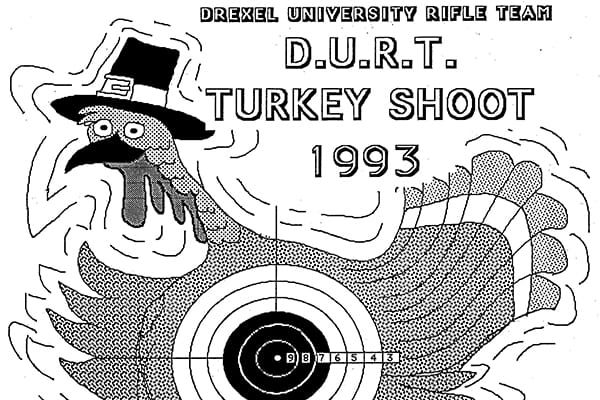A Drexel Thanksgiving Turkey Shoot? It Was a Real Tradition, Just 10 Years Ago

Back in the day, a couple of lucky Drexel students could bring back more than a pile of laundry for Thanksgiving break. If they had participated in the annual turkey shoot fundraiser put on by Drexel’s now-defunct rifle team as recently as 10 years ago, they could have won a frozen turkey for Mom to use in the family feast.
Beginning in 1984, the Drexel University Rifle Team (DURT) held an annual “turkey shoot” open to all students, faculty and employees. They didn’t shoot at real turkeys, but at paper turkey targets, using .22-caliber rifles. The contest started when the self-managed club sport needed a way to pay for equipment and maintenance of the rifle range, which was located between the third and fourth floors of Curtis Hall and is now a research facility.
“The turkey shoot was born out of necessity. If we wanted to have any repair or maintenance in the range, we had to pay for it. If we wanted new equipment, we had to pay for it,” said Perry McFarland, a Drexel alumnus and former rifle team member. McFarland graduated with a degree in business administration and is now associate dean for finance and administration at the School of Public Health.
McFarland helped create and implement the turkey shoot during his undergraduate years on the rifle team in the ‘80s. After he graduated, he served as the assistant coach of the team. His love of the sport and the Drexel team ran in the family: His father, Jerry McFarland, coached the rifle team from 1981 to 2000 while he was director of Drexel’s Planning, Design and Construction department.
In concert with the team’s success in intercollegiate competition, the turkey shoot was regularly held during the ’80s, continuing periodically in the ’90s and early ’00s. After being temporarily frozen during those years, the rifle team was eventually shut down in 2003.
For obvious reasons, DURT substituted real turkeys with cartoon turkey targets (sometimes depicted wearing the traditional black Pilgrim hat or even carrying their own rifles), with frozen Butterball turkeys as prizes.
“No animals were ever harmed in our turkey shoot,” McFarland joked.
The Drexel event was based on the traditional turkey shoot — the kind in which participants shot at real birds. Once a popular pastime on the 19th-century American frontier and the 20th-century countryside, the turkey shoot has waned in popularity since.
At the Drexel shoot, the turkey targets generally featured a bull’s-eye that was located on the turkey’s breast and measured roughly .25 centimeters in diameter — 50 feet away from the shooter. The highest possible score was 50 points, or five bull’s-eyes; most winners had scores in the upper 40s.
Participants could also take top honors by scoring the highest in different categories if they joined a team of at least four people. Students could shoot by dormitory floor, major or fraternity or sorority, while faculty and staff were classified by department.
“People got excited by the teams and rivalries,” McFarland said. “It wasn’t just a team from Kelly Hall. It could be the second floor of Kelly Hall versus the third floor of Kelly Hall.”
Most high-ranking officials like vice presidents, provosts and even University presidents participated or sent representatives from their offices. William W. Hagerty and Harold M. Myers took part during their tenures as Drexel president; Myers’ score of 38 in the 1987 competition placed in the 95th percentile of shooters.
In 1989, the top administration team was Planning and Construction, as the department was then called, with a score of 187/200. That same year, the top student organization was WKDU Radio, for whom McFarland served as a technical adviser, with a score of 171/200.
Many people paid for more than one round of shots, since the highest score counted no matter how many tries it required. The University even started requiring student organizations to do fundraising after the rifle team started raising its own funds independently, and the student activities organization made self-fundraising a metric for evaluating student organizations.
Members of Facilities Management and other departments often had targets taped to their doors, as did students living in dormitories. November was the time of the year when a large number of the Drexel community engaged with the rifle team and rifle range. In 1987, a full 6 percent (605 people) of the Drexel population took part in the shoot, according to student and staff numbers from the U.S. Department of Education.
DURT’s last turkey shoot was held in 2003, the final year of the organization and its rifle range. At the time, the organization was the nation’s second-oldest collegiate rifle team, having been established in 1919.
Drexel News is produced by
University Marketing and Communications.

